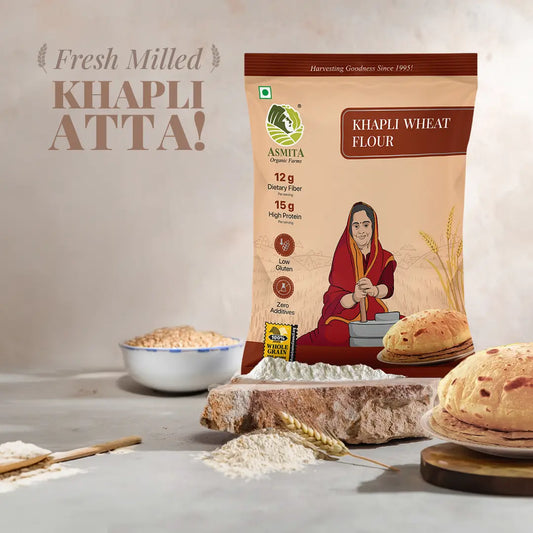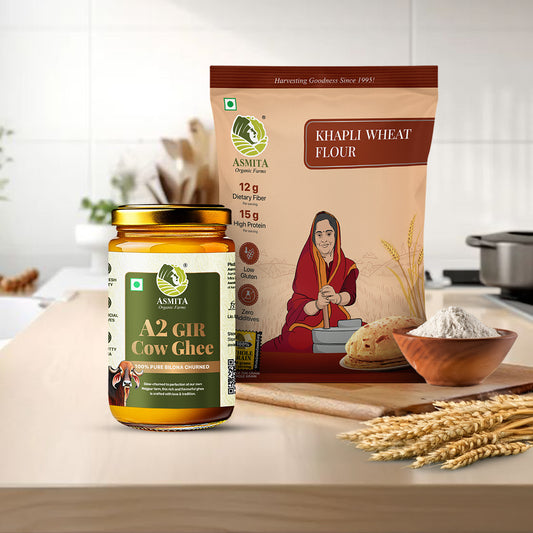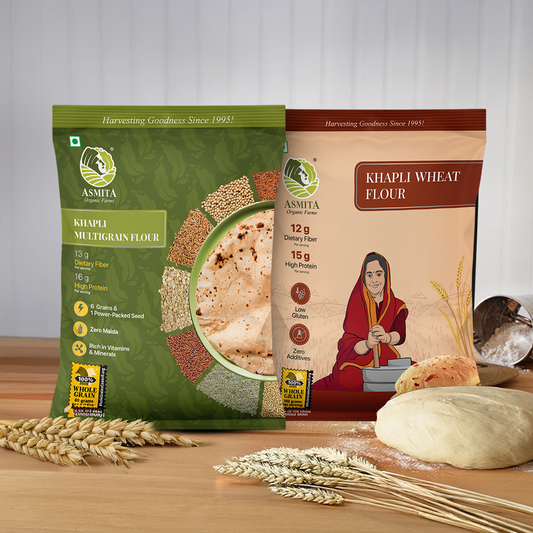What is Khapli Wheat Flour? Benefits & How to Use It
5 min read
Khapli Wheat Flour is made from Khapli wheat, also known as emmer wheat flour. It is one of the oldest cultivated grains in the world and belongs to the group of ancient grains.
If you’re wondering what is khapli wheat flour, it’s a traditional flour with a reddish-brown outer layer, known for its dense nutrition and natural taste. This might not be news to those who’ve been into healthy eating for a while now, but Khapli wheat flour is showing up in kitchens where people are looking for something more wholesome than regular wheat.
And once you start reading about the Khapli Atta benefits, it becomes clear why.
Table of Contents
1. What is Khapli Wheat?
2. Nutritional Profile of Khapli Atta
3. Health Benefits of Khapli Wheat
4. Is Khapli Wheat Gluten-Free or Low Gluten?
5. How to Use Khapli Flour in Cooking
6. How to Choose Quality Khapli Flour
7. Bottom Line
What is Khapli Wheat?
The origins of khapli wheat trace back to the Fertile Crescent, the region known for early agriculture. Over time, it spread to India, where it remained a part of traditional farming practices in states like Maharashtra, Karnataka, and Madhya Pradesh.
Khapli wheat, or triticum dicoccum, is also part of the Ayurvedic grains family, valued for its role in supporting digestion and energy. The grains themselves are long and reddish-brown, and they come with a thick husk that gives them a certain earthiness.
It’s not polished or over-processed, and that’s exactly why people who are interested in ancient grains or anything that’s less tampered with are starting to notice it more and more.
Nutritional Profile of Khapli Atta
If you’ve ever wondered what is khapli wheat flour doing in all these wellness circles lately, the secret’s in what it’s made of. The wheat is nutrient-packed and surprisingly gentle on the system.
When people switch from regular wheat to emmer wheat flour, they’re choosing a more mindful, balanced approach to their diet. Let’s break it down:
- Fibre-rich flour goodness: Khapli is naturally loaded with dietary fibre, which your gut absolutely loves. It keeps things moving, smooth, and easy.
- A decent punch of protein: With around 15% protein content, it actually edges out regular wheat, something fitness-minded folks are starting to notice.
- Low gluten flour alternative: Not totally gluten-free, but lighter on the gluten load, which is a win for those who want something gentler.
- A kinder glycemic profile: This one’s a diabetic-friendly flour, too. With a lower glycemic index, it won’t spike your blood sugar the way refined grains can.
- Micronutrient magic: It’s packed with B vitamins, iron, magnesium, zinc, the kinds your body uses quietly but constantly.
Here’s the nutritional information per 100 g:
|
Nutrient |
Per 100g |
% RDA per serve |
|
Energy (kcal) |
387.2 |
19.4 |
|
Protein (g) |
15.73 |
28.6 |
|
Carbohydrate (g) |
75.13 |
57.8 |
|
Total Sugars (g) |
6.11 |
– |
|
Total Fat (g) |
2.64 |
3.9 |
|
Saturated Fat (g) |
0.47 |
2.1 |
|
Trans Fat (g) |
0 |
0 |
|
Cholesterol (mg) |
0 |
0 |
|
Sodium (mg) |
6.19 |
0.3 |
|
Dietary Fiber (g) |
10.93 |
– |
Health Benefits of Khapli Wheat
Khapli wheat flour is gaining popularity for clear and practical reasons. People are choosing it because it works well for their health goals and fits easily into their daily diet.
The Khapli Atta benefits go beyond trends and focus on nutrition that delivers real results.
Supports digestive health: Khapli Atta is a fibre-rich flour that supports healthy digestion. It helps prevent constipation and improves gut function.
- Helps manage blood sugar: Khapli wheat has a lower glycemic index (GI) than regular wheat. It releases sugar into the bloodstream more gradually. This makes it a reliable diabetic-friendly flour for people who want better control over blood sugar levels.
- Good for heart health: Khapli Wheat Flour provides nutrients like magnesium and natural antioxidants. These support cardiovascular function and may help reduce the risk of heart-related conditions. Regular use in meals contributes to a more balanced nutrient intake.
- Supports healthy weight management: The high fibre content (10.93 g per 100 g) of this ancient grain helps you feel fuller for a longer time. This reduces the need for frequent eating and supports healthy meal patterns. People looking for simple and natural ways to manage weight often benefit from adding Khapli Wheat Flour to their routine.
- Boosts energy and immunity: This emmer wheat flour contains essential minerals like iron and zinc. These nutrients support immune strength and maintain consistent energy levels. It is a practical way to meet daily nutritional needs through regular meals.
- Improves metabolism: The B vitamins in Khapli wheat support efficient metabolism. They help in energy production and the breakdown of food into usable nutrients. This makes it useful for people seeking better nutritional balance without using supplements.
Is Khapli Wheat Gluten-Free or Low Gluten?
Khapli wheat is not gluten-free. But that doesn’t mean it’s off the table for everyone avoiding gluten.
What sets it apart is that it contains less gluten than the wheat most of us grew up eating. When comparing Khapli vs wheat, Khapli contains more fibre, lower gluten levels, and a lower glycemic index.
This lighter gluten profile makes it a go-to low gluten flour for people who aren’t necessarily celiac, but who feel a little off after eating regular wheat. A lot of folks with mild sensitivities say they find Khapli atta much easier on the tummy.
People who are mindful of panjiri calories often prefer Khapli atta for its wholesome profile and slow sugar release. That said, if you’ve got full-blown gluten intolerance or celiac, this flour still isn’t the right match.
Still, for those looking for a digestible and more traditional grain option, emmer wheat flour lands right in that sweet spot, not entirely free of gluten, but way less aggressive than modern wheat.
How to Use Khapli Flour in Cooking
Khapli Wheat Flour fits right into your usual routine and brings a warm, nutty twist to your everyday meals. Here are a few easy ideas:
- Chapatis and Rotis: Swap it in 1:1 with your regular atta. Your roti will get a softer texture and a deeper, more rustic flavour.
- Breads and Buns: Mix it with a little all-purpose flour for that bakery-style crunch and colour.
- Cookies and Cakes: Add in a portion for that wholesome bite without sacrificing taste.
- Pancakes and Dosas: Yes, it works for both—Indian breakfasts and Sunday stacks.
- Homemade Pasta & Noodles: Use it to give your pasta that earthy edge with bonus nutrition.
Khapli is a bit more absorbent than your standard flour, so you might want to play around with your water ratios the first few times.
How to Choose Quality Khapli Flour
Since it’s gaining popularity, it’s important to know what you’re buying. Here's what to keep an eye on:
- Go for trusted sellers: For authentic and nutrient-rich Khapli Atta, choose AOF, a trusted source for 100% emmer wheat flour, naturally grown and stone-ground for maximum freshness and purity.
- Smell it: Fresh Khapli wheat flour should have a warm, nutty aroma. If it smells musty or flat, skip it.
- Check the colour: Check the colour carefully. A good batch of Khapli Atta will have a natural reddish-brown hue that reflects its rich and earthy grain quality, not a bright white appearance.
- Read that label: Look for 100% emmer wheat flour or 100% Khapli wheat. Avoid blends with regular wheat unless that’s what you're going for.
Bottom Line
Whether you’re here to research more about what is khapli wheat flour, or simply looking for a wholesome alternative that feels closer to the earth, Khapli Wheat Flour is a smart switch.
And when it comes to quality you can trust, AsmitA Organic Farms has your back. We’re committed to offering authentic, nutrient-dense staples that support your wellness journey from the inside out.
Cook with purpose, eat with intention, and experience the power of food that still remembers its roots. Order now!






